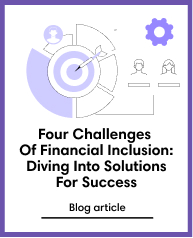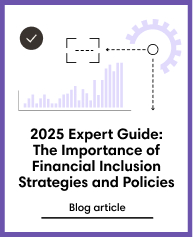Financial Inclusion
Nov 12, 2021
Financial Inclusion In India: Progress, Challenges And The Fintech Role
Subscribe to our newsletter
India is rapidly emerging as one of the world’s largest financial technology markets, and for good reason.
While 20 million people remain unbanked, over 622 million Indians used the internet in 2020, projected to reach 900 million by 2025. This growth fuels financial inclusion in India, as fintech innovations expand access, trust, and digital participation nationwide.
This article answers a common question, “What is financial inclusion in India?”, while also explaining how progress is measured and which initiatives are shaping a more inclusive financial ecosystem.
What is Financial Inclusion and Why Does It Matter?
Financial inclusion means providing affordable access to useful and responsible financial products, such as savings, credit, insurance, and payments, to individuals and businesses, regardless of income or geography.
Financial inclusion in India is not only about opening bank accounts; it is about enabling citizens to manage money, build savings, and access credit safely.
You might ask, “Why financial inclusion is important in India?” It matters because it helps reduce poverty, creates employment opportunities, and advances gender equality.
Measuring Progress: The RBI’s Financial Inclusion Index (FI-Index)
The Reserve Bank of India (RBI) created the Financial Inclusion Index (FI-Index) to track nationwide progress in financial accessibility. Built on a Three-Pillar Framework: Access (35%), Usage (45%), and Quality (20%), it evaluates reach, engagement, and service standards.
According to the Reserve Bank of India (RBI), as reported by Business Standard, India’s Financial Inclusion Index (FI-Index) rose to 67.0 in March 2025, up from 64.2 in March 2024, signalling stronger participation, wider access, and improved quality of financial services countrywide.
More than just a metric, it reflects how inclusion has evolved from basic access to meaningful usage, helping policymakers assess how effectively financial systems enhance lives and drive sustainable economic development across regions.
The Pillars of India’s Financial Inclusion Drive
India’s success stems from a combination of government initiatives and digital transformation, which together have accelerated digital financial inclusion in India.
1. Government Flagship Schemes
Over the past decade, several financial inclusion schemes in India have expanded access and trust:
- Pradhan Mantri Jan Dhan Yojana (PMJDY): Launched in 2014, this remains the world’s largest inclusion drive, opening over 500 million bank accounts.
- Pradhan Mantri Mudra Yojana (PMMY): Offers collateral-free loans to micro and small enterprises, boosting entrepreneurship.
- Atal Pension Yojana (APY): Provides retirement security for informal sector workers.
- Stand-Up India: Encourages entrepreneurship among women and marginalised communities through accessible bank credit.
These schemes have moved millions from cash-based transactions to digital banking, reshaping the financial landscape.
2. The Digital Revolution
India’s digital transformation has been pivotal. Platforms such as the Unified Payments Interface (UPI) and Aadhaar-enabled Payment Systems (AePS) have made instant, secure transactions possible, even in remote villages.
According to the Press Information Bureau (PIB), UPI now processes billions of transactions each month, demonstrating growing public confidence in digital payments.
This digital shift has accelerated financial inclusion in India, bridging the gap between urban and rural populations through simple, smartphone-based services.
The Role of FinTech and Digital Lending
Growth of FinTech in India
While the genesis of the Indian fintech sector started a few years back, 2015 became a formative year for the country due to the emergence of numerous fintech start-ups, incubators, and investments from public and private investors.
The rise of fintech became a breakthrough in the country’s cash-driven economy because of increased e-commerce activity and smartphone penetration as well.
Since then, some of the leading fintech solutions taking India by storm belong in the categories of digital payments, digital lending, and wealthtech, among other things.
More than half of the 2,100 fintech companies in India in operation today were established in the last five years, with most of them located in Bengaluru and Mumbai.
Even in the midst of the COVID-19 pandemic, 33 new fintech investment deals worth $647.5 million in India were made in June 2020, which was significantly bigger than investments made in China, amounting to $284.9 million in the same period.
India’s fintech market is now valued at US$31 billion and projected to grow to US$84 billion by 2025.
India is evidently quick with its fintech innovations, partly thanks to the full support of the Indian government towards fintech operations in the country.
While India still lacks a single set of regulations that govern fintech products, some of the regulatory frameworks that include fintech operations are the PSS Act (Payment and Settlement Systems Act), PPI (Producer Price Index) Master Directions, UPI Procedural Guidelines governed by the National Payments Corporation of India (NPCI), and Payment Intermediary Guidelines.
Moreover, the Indian finance sector has collectively settled with a more collaborative model instead of one that revolves on competition, with banks and non-banks teaming up and fusing their solutions together to help their customers access financial products and services better.
Digital Lending for Financial Inclusion
Digital lending has been instrumental in bridging gaps in the Indian financial sector over the past few years.
For instance, individuals and micro, small, and medium enterprises rejected by traditional banking loans now turn to digital lending solutions since digital lending companies ask for less requirements and process applications faster.
Data shows that only 10% of Indians have access to organised credit. Digital lending solutions have also been helpful amid the pandemic, which created an increased demand for credit in the country.
Because of this growing demand and its clear role in promoting financial inclusivity, digital lending has become one of the fastest-growing fintech segments in India, growing exponentially from US$9 billion to nearly US$110 billion within a seven-year period.
To keep up with this growth, regulatory bodies in India are working to modulate digital lending activities.
Just early this year, the RBI created a working group to study the aspects of digital lending activities, such as those done on online platforms and mobile apps, in the regulated financial sector and activities led by unregulated players.
According to the RBI, digital lending can potentially make access to financial products and services more fair, efficient and inclusive. From only fulfilling a supplementary role in finance, digital lending now sits at the core of the design, pricing, and delivery of finance solutions.
As digital lending rises in popularity, alternative credit scoring methods rise in parallel as well.
Borrowers, such as small merchants like kirana store owners, who have been denied loans due to their lack of credit history, rely on alternative sources of data, such as their utility payment profile, location data, and asset ownership, to get real-time credit scores and, eventually, small-ticket loans.
The use of alternative sources of data, which then empowers alternative credit scoring methods, comes from the rapid embrace of digital payments in India as well.
Ultimately, the increase in the usage of digital data points is further widening the scope for alternative lending in the Indian market.
The Way Forward: Strengthening India’s Financial Ecosystem
While progress is undeniable, achieving universal inclusion requires continued innovation, education, and infrastructure development.
Strengthening Digital Infrastructure
Projects like BharatNet aim to extend broadband access to India’s remotest regions, ensuring that rural citizens can benefit from digital services and mobile banking.
Enhancing Financial Literacy
To make inclusion sustainable, India must promote financial awareness. Integrating financial education into school curricula and community programmes will help citizens understand savings, credit, and risk management.
Promoting Inclusive Credit Solutions
Expanding collateral-free lending and alternative credit scoring solutions can help small businesses access loans quickly. Collaboration between fintechs and banks can simplify credit assessment and reduce default risks.
Through these measures, India can further strengthen its digital ecosystem and make inclusion more accessible, transparent, and data-driven.
A Fairer Financial Future
India has made remarkable progress in expanding financial access through government initiatives and digital innovation. Yet, true inclusion goes beyond opening accounts; it demands trust, education, and active usage.
Strengthening literacy, credit access, and digital infrastructure will ensure that financial inclusion in India becomes a driver of equality and sustainable growth.
What do these stats mean for you?
As access to traditional credit and loans become harder and harder to attain, digital lending and alternative credit scoring solutions are stepping in to promote financial inclusion in India. With its technology, Credolab can help new lenders and creditors in India speed up their credit processing operations and improve their credit risk management, all while protecting the data of their customers. Thanks to technology, more unbanked people in India will finally be able to achieve their financial goals.
FAQs
Why Digital Payments Matter for Inclusion?
Digital payments make transactions faster, transparent, and accessible, reducing dependence on cash and promoting safer participation in the economy.
Who Recommended Financial Inclusion in India?
The Rangarajan Committee (2008) defined financial inclusion as universal access to financial services and recommended national strategies to achieve it.
When Did Financial Inclusion Start in India?
The concept gained traction in 2005, when the RBI urged banks to adopt inclusive practices and introduce zero-balance accounts.
What Is the National Strategy for Financial Inclusion in India?
The National Strategy for Financial Inclusion (NSFI) 2019–2024 provides a roadmap for universal access to quality financial services.
What Are the Two Government Schemes for Financial Inclusion in India?
The Pradhan Mantri Jan Dhan Yojana (PMJDY) and Pradhan Mantri Mudra Yojana (PMMY) are India’s flagship financial inclusion schemes.
Which Is the Biggest Financial Inclusion Exercise of the World?
The Jan Dhan Yojana is globally recognised as the world’s largest financial inclusion initiative, both in scale and impact.





